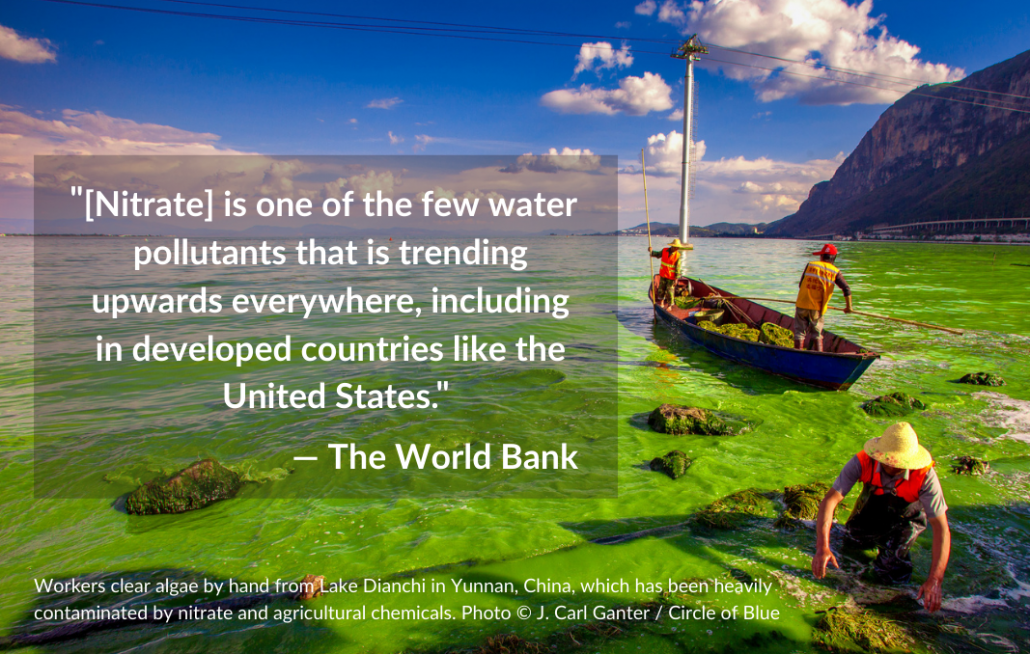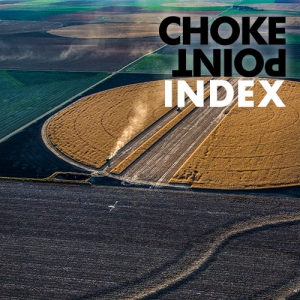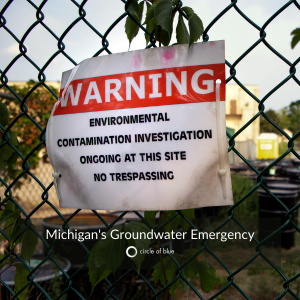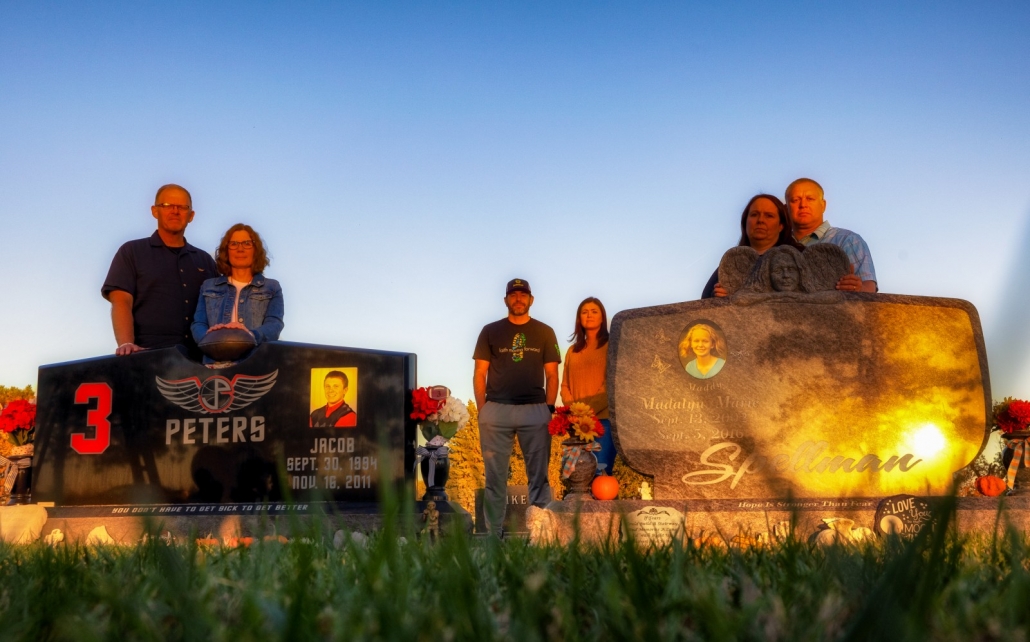
Is Agrochemical Contamination Killing Nebraska’s Children?
The harrowing trail of toxic nutrients in farm country water
This is the first of a two-part series. Read part two here.
By Brett Walton, Circle of Blue – February 2, 2022
Photography and videography by J. Carl Ganter
AURORA, Neb. — In the final, frantic hours Jacob Peters’s body gave out. As nurses worked to stabilize his vitals, his blood pressure dropped. Fluid built up in his abdomen and brain. He vomited. His words were slurred.
A ventilator kept the 17-year-old alive long enough for his younger brothers, Jerod and Dalton, and other family members to make the two-hour drive to the Omaha hospital where his parents stood vigil. On November 16, 2011, at 6:12 p.m., Jacob died, nine months after he was diagnosed with a rare and aggressive form of lymphoma.
A decade later, Jacob Peters’s death turns out to be much more than a dreadful heartbreak for a small town, farm country family. His parents, Gary and Shari Peters, documented six more kids in Aurora diagnosed with cancer from 2005 to 2013. Of the seven, including Jacob, Circle of Blue confirmed that five died and two survived.
There are others across Nebraska. The Centers for Disease Control and Prevention counts 1,921 pediatric cancer cases in the state between 1999 and 2018, about 100 per year.
An investigation by Circle of Blue uncovered compelling evidence for why — agrochemical contamination in Nebraska’s surface, ground, and drinking water. The reporting found:
- Pediatric cancer is more common in Nebraska than anywhere in the United States outside of the Northeast. The state’s pediatric cancer rate is seventh-highest in the country.
- High numbers of pediatric cancer cases, especially central nervous system tumors, leukemia, and lymphoma, are associated with Nebraska watersheds that have high levels of nitrate (a fertilizer) or atrazine (a weed killer) in surface and groundwater, according to a University of Nebraska Medical Center research team.
- Statistical analysis points to agrochemical pollutants in streams and groundwater as a potential source of Nebraska’s outsized pediatric cancer caseload.
- Nitrate is one of the most violated federal drinking water standards, with EPA data showing 458 systems in violation in the fourth quarter of 2021. Twenty-three are in Nebraska.
- Farms collectively are the largest source of nitrate pollution in rivers and groundwater, and the penalty for contaminated water — meaning stricter and more costly standards in order to protect public health — is paid by the people who drink it.

This map shows nitrate concentrations in drinking water between 2016 and 2018 for federally regulated water systems. Dark blue dots indicate water systems that exceeded the federal nitrate standard of 10 parts per million. Light blue dots show systems just under the standard, where concentrations were between 5 ppm and 10 ppm. The areas with high nitrate concentrations generally correspond to areas with intensive agriculture where groundwater is a major water source.
States shaded white did not provide or have data. The map shows a combination of nitrate and nitrate-nitrite data from state and federal sources. The map was produced by Corona Environmental Consulting based on a data-collection project funded by the Water Quality Research Foundation.
In the annals of toxic chemical contamination in the U.S. and globally, agrochemicals used to increase crop production, kill insects and weeds, and prevent plant and animal diseases are well-recognized hazards. In weighing the documented risks to health and the environment against the benefits of an ample food supply at reasonable prices regulatory authorities have been reluctant to exert strong safeguards except in the most egregious instances — like banning DDT in 1972 because it prevented birds from reproducing.
Even with that record of risk nitrate pollution is in a category to itself. The chemical fertilizers that farmers insist are needed to assure high crop production, and the nitrogen-rich manure produced by contemporary animal agriculture, are largely unregulated. The result is nitrates are causing health and ecological trauma in farming regions across the country and around the world as farmers and governments intensify their efforts to produce more food from each acre of land.
Purging nitrate from groundwater will not be a quick fix. Nitrate is water soluble and soils are loaded with excess fertilizer that could take decades to expunge, even if new nitrogen application on farmland is curtailed. The long memory of this legacy nitrate is likely to be rattled by a changing climate. One recent study found that more intense precipitation, as is expected in the Midwest and Great Plains in the coming decades, could flush more nitrate from soils to groundwater, especially from fields that are tilled.

A small but growing body of research suggests that agrochemical pollutants in groundwater and streams, like Bazile Creek, shown here, play a role in Nebraska’s outsized pediatric cancer caseload.
In the United States, excess nutrients build up in waterways from Lake Erie to the Gulf of Mexico, precipitating algae outbreaks that kill fish, close public drinking water utilities, and pollute water. Politically powerful farm lobbies, preferring voluntary measures to curb nutrient pollution, have held off oversight under the Clean Water Act and other statutes. Fertilizer runoff from farm fields is not federally regulated, so the EPA’s announcement on January 26 that it would step up enforcement of polluting facilities has little resonance for nitrate contamination.
What’s happened in Nebraska to kids and their families may help change the official indifference. A small but growing body of research suggests that agrochemical pollutants in streams and groundwater play a role in Nebraska’s outsized pediatric cancer caseload. That line of inquiry points at the heart of the Nebraska economy: its $21.4 billion farm industry.
Nebraska agriculture is a behemoth. More than nine out of every 10 acres in the 49.5 million-acre state is given over to farms and ranches. Collectively they produced 294 million bushels of soybeans in 2020, ranking fifth nationally. Grain corn was even better, third nationally with 1.79 billion bushels. The state produced nearly 8 billion pounds of red meat.
Such prodigious output requires enormous inputs, especially of nitrogen fertilizers.
Fertilizers developed to produce huge harvests across the Corn Belt have also been found to wreak havoc on human bodies. So have farm chemicals like atrazine, a weed killer.

Don Coulter, center, speaks with Jesse Bell, right, and Eleanor Rogan. The three University of Nebraska Medical Center researchers are part of a collaborative project investigating the links between water pollution and pediatric cancer in Nebraska.
Don Coulter, the director of the University of Nebraska Medical Center’s Pediatric Cancer Research Group, is one of the medical specialists taking a close look at the links between farm chemicals and Nebraska’s pediatric cancers. He is part of a research team that mapped three decades of pediatric cancer cases in Nebraska not according to political boundaries, such as counties or towns, but instead by watersheds. Coulter has a particularly keen interest. He was one of the doctors on Jacob Peters’s care team.
The mapping project shows that cancer cases are associated with watersheds that have high levels of nitrate or atrazine in groundwater. The Upper Big Blue watershed in south-central Nebraska, where the Peters family lives, is one of the basins with a high cancer incidence.
Besides Jacob Peters, four of the Aurora kids died from their cancers. Tyler Larson was diagnosed in 2010 with neurofibroma sarcoma, which resulted in tumors on nerve endings. He was 19 when he died. Sydnee Owens, who contracted non-Hodgkin’s lymphoma in 2006, died six years later at age 14. Alyssa Sandmeier died at age 10 from leukemia. And Madalyn Spellman died at age 13 after being diagnosed with leukemia and bone cancer. Two kids survived and they or their parents did not respond to interview requests.
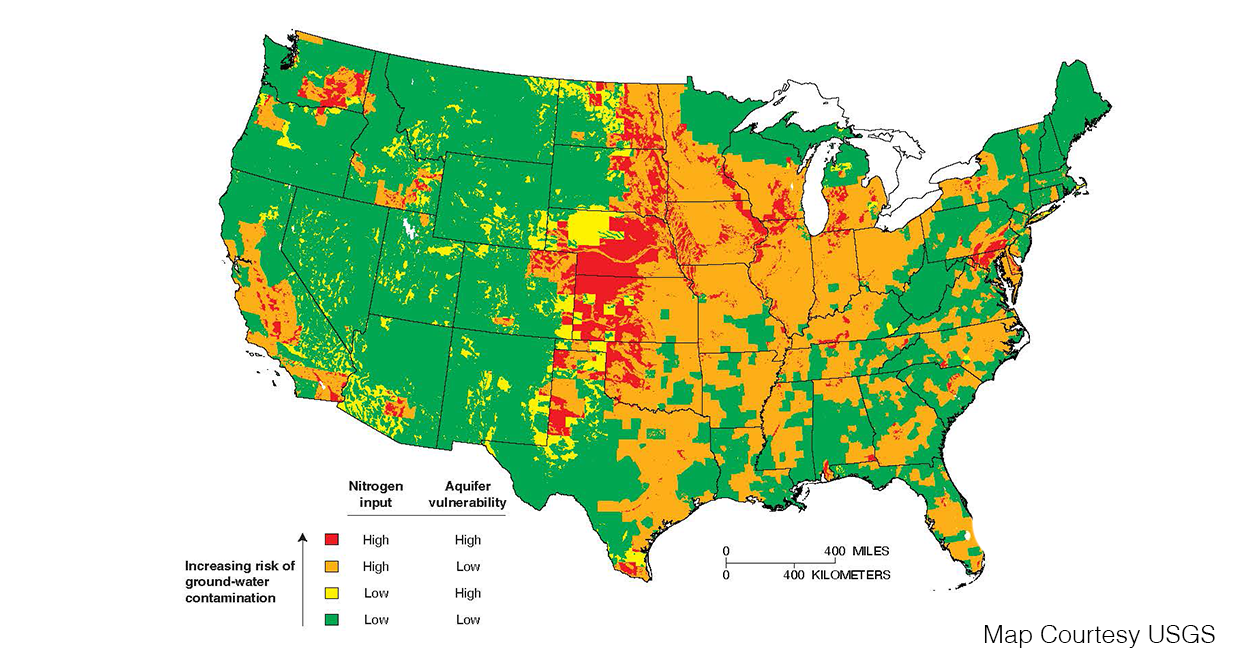
This U.S. Geological Survey map shows areas at risk of nitrate contamination in shallow groundwater. Areas shaded red have the highest risk, meaning high nitrogen use from agriculture and aquifers that are vulnerable to contamination – typically those in sandy soils.
Studies and Questions
The complexity of the nitrate problem, unknotting its social, economic, medical, political, and practical threads, is part of the appeal for Coulter.
With fresh eyes, Coulter came to the issue after caring for Jacob and another pediatric cancer patient in 2011. It was three years after he arrived at the University of Nebraska Medical Center following medical school at the University of Arizona and residency in North Carolina. It was a career shift. Before becoming a doctor he worked at Charles Schwab.

Eleanor Rogan, chair of the Department of Environmental, Agricultural, and Occupational Health.
Teamwork was a big part of the finance job, and that is what Coulter, with the aid of $1.8 million annually from the state Legislature, has helped create at the University of Nebraska Medical Center. The collaborators on the water and cancer research project include, among others, Eleanor Rogan, chair of the Department of Environmental, Agricultural, and Occupational Health, and Jesse Bell, director of the Water, Climate and Health Program. The group has also elicited the help of two natural resources districts — the Lower Elkhorn and Upper Big Blue — which have a regulatory role in Nebraska over issues like water quality and soil erosion.
The team’s approach appeals to Rogan because she is far more interested in disease prevention than disease treatment. “For me, once you have a tumor cell I’m not interested anymore because I didn’t want you to have a tumor cell,” she told Circle of Blue.
Coulter said that he sees his role to be that of a facilitator, connecting across disciplines and identifying new lines of questioning. “Science in a silo doesn’t work,” he says. The work on environmental factors has prompted many questions. Why does Nebraska have higher pediatric cancer rates than its neighbors Iowa and Kansas, even when they share similar agricultural risks? What is the interaction between nitrate and uranium, which is naturally present in Nebraska groundwater? And should the U.S. regulatory system, when looking at the variety of chemical pollutants in drinking water, continue to assess the toxicity of contaminants individually?
“Sure, you can do that,” Coulter said about considering contaminants one by one. “But another way to think about it is that when something grabs a glass of water, and it has all those different compounds within it, what are those compounds doing within a glass of water to allow one to be more bioavailable or problematic than it would be if it was just in isolation? And so we have to provide that data and not try to necessarily interpret it for people, but sort of show them, ‘Hey, this is what we found in this watershed. These are the compounds that are all playing in this person’s well. This could be an issue.’”
Coulter added: “We know these compounds are problematic. We may not be able to find something definitive for cancer, but at least it’s helping people to identify that this is something we need to be thinking about.”

Nighttime harvest, east of Creighton, in north-central Nebraska.
The work seems to be moving minds. In Nebraska, at least, Coulter has seen a more intense focus in the last five years on water pollution. “I think for a long period of time, it was always about the quantity of water. Do we have enough? Now I think people are also looking at the other side of that coin and saying what are we doing to our water supply? And what sort of impacts is that having?”
The findings from the University of Nebraska team contribute to a larger body of research investigating the health consequences of one of the country’s most pervasive drinking water contaminants. Research on nitrate is generating limited but compelling evidence of acute and chronic health damage when the chemical is present in drinking water at concentrations above and below the current federal standard of 10 parts per million. It comes at a time when the U.S. Environmental Protection Agency is undertaking a mandatory review of federal drinking water standards, due in 2023.
A Standard Under Scrutiny
The federal nitrate standard was set three decades ago to protect infants from a disease called blue baby syndrome. Now there are new worries. Recent studies in the United States and Denmark on nitrate exposure indicate a higher risk of preterm birth, low birth weight, birth defects, and infant brain tumors. In adults, there is a higher risk of colorectal cancer and some associations with thyroid disease. These associations are present when nitrate is above and, in some cases, below the federal drinking water standard.
“There seems to be quite a growing literature that suggests that the standard that was really based on blue baby syndrome is not sufficiently stringent to protect children from other adverse birth outcomes,” Leslie Stayner, a professor emeritus of epidemiology at the University of Illinois at Chicago, School of Public Health, told Circle of Blue. Stayner currently lives in Denmark, where he is using that country’s meticulous data registries to investigate the health damage from nitrate.
Researchers who specialize in the health effects of nitrate say that more work needs to be done to establish cause-and-effect relationships. In the field of epidemiology, and especially in drinking water assessments, no single study is ever definitive.
“Taken together these studies add to the evidence for adverse health effects related to nitrate ingestion at levels below the current regulatory standards in the U.S. and E.U.,” said Mary Ward, a senior investigator at the National Cancer Institute. “However, the number of studies is still too few to draw conclusions about risk.”
If the U.S. Environmental Protection Agency were to lower the nitrate standard — something the agency rejected in 2016, in its last review of federal drinking water regulations — the consequences would be enormous. The risk of disease would likely decrease. But more communities would violate the standard and would be required to upgrade their treatment works or find new water sources with lower levels of nitrate. That is a difficult proposition in farm country, where a town may be surrounded by high-nitrate groundwater. In deciding whether to lower the standard, the EPA would weigh the reduction in health risks against these community financial liabilities.

Soybean harvest in late October.
Nitrate is already one of the most violated federal drinking water standards, with EPA data showing 458 systems in violation in the fourth quarter of 2021. Yet, it remains overlooked. Spurred by public outrage after high-profile health crises in the last decade, other drinking water contaminants have taken center stage in the federal response to dirty water.
The $1.2 trillion infrastructure package that President Joe Biden signed into law in November included $15 billion to remove lead pipes and $10 billion for dealing with toxic PFAS chemicals. But there was no specific earmark for utilities to address nitrate.
Chad Seidel, who works on drinking water treatment and policy, says he is frustrated with the lack of attention to such a deeply rooted, widespread problem. “If we were addressing nitrate with the fervor we’re currently addressing PFAS, we would have solved the problem a decade ago,” said Seidel, president of Corona Environmental Consulting. “But we haven’t. We’ve accepted the fact that hundreds and hundreds of water systems across the U.S. can be out of compliance. And we’re okay with it.”
Nitrogen Fixation
Though notorious as a water polluter, nitrate is regarded by farmers as absolutely necessary and by industrialists as one of the great discoveries of the 20th century. By combining inert nitrogen gas with hydrogen sourced from fossil fuels, two German scientists at the start of the century learned they could “fix” nitrogen from natural gas to produce fertilizers whose provenance previously had been the domain of lightning, legumes, and manure.
The Haber-Bosch process “changed the world,” according to one scientific retrospective. The widespread availability of manufactured nitrogen fertilizers caused crop yields to soar. Nitrogen use rose exponentially after World War Two before leveling off in the 1980s and growing more slowly thereafter.
Environmental problems developed in tandem with nitrate’s swift ascent. Corn and soybeans couldn’t consume all of the nitrogen they were fed. Some residual nitrogen was lodged in soils where microbes converted it into nitrous oxide, a significant greenhouse gas. The rest was flushed from fields into rivers, or it leached into shallow groundwater. The nutrient-laden runoff fed the growth of algae in lakes and estuaries. Oxygen-deprived “dead zones” developed in the Gulf of Mexico and Chesapeake Bay, key waterways downstream of intensive farming.
For people who consumed water high in nitrates health problems emerged starting in the 1940s. The pathway is indirect. In the body, nitrate is converted into nitrite by bacteria in saliva. Nitrite then reacts with ferrous hemoglobin, a compound in blood that transports oxygen from the lungs to cells and tissues. From this interaction comes methemoglobin, which cannot carry oxygen. Starved of a critical element of life, methemoglobinemia patients begin to suffocate from within, their skin drained of color, sometimes acquiring a blue tint.
Adults are not at risk, but bottle-fed infants are particularly defenseless, thus the common name for the disease: blue baby syndrome. Once infants in farm communities began to die, researchers snapped into action. They found that reducing nitrate in drinking water substantially reduces the risk of infant death. For that reason, in 1991, the EPA established a federal nitrate standard of 10 parts per million in drinking water, roughly in line with World Health Organization guidance. Utilities developed methods to reduce or remove nitrates. Health officials warned household well owners, whose water is not regulated, about the dangers. Deaths of blue-tinted infants almost disappeared by the late 1990s. The standard has not been changed since.
New research is starting to call that standard into question. One area of concern is cancer. Nitrate converts to nitrite in the mouth, which can interfere with oxygen transport in the blood. Thus methemoglobinemia. But nitrite has another indirect route for damaging the body. It interacts with acids in the stomach to produce carcinogenic N-nitroso compounds.
N-nitroso compounds can cross the placenta and expose a child in utero. Leslie Stayner, the University of Illinois at Chicago epidemiologist, said that his research has led him to the conclusion that pregnant women should be cautious about their drinking water, not only for nitrates but for other chemicals in low concentrations that could pass to the fetus.
For newborns, four out of six studies showed communities prevalence of birth defects of the central nervous system at nitrate levels below the EPA standard of 10 parts per million. The evidence of harm is growing, but it is far short of the amount of study needed for scientific consensus. “In the epidemiology field, these are not a lot of studies,” said Mary Ward of the National Cancer Institute.
Ward said that diseases related to drinking water nitrate are probably due to a combination of two factors: nitrate ingestion and the body’s production of N-nitroso compounds. Factors that would increase N-nitroso production include a person’s diet. Eating more steaks and hamburgers increases the risk. Eating more foods rich in antioxidants, like fruits and most vegetables, lowers it. Joseph Cotruvo, a former director of the EPA drinking water standards division, said more work needs to be done to account for dietary nitrate when assessing health risk.
Decades of exposure to nitrate for high-risk people can also lead to chronic ailments like cancer. Ward, one of the country’s foremost nitrate researchers, pointed out that the strongest associations between nitrate and cancer are with colorectal cancer (four studies out of five total showing a link for at least one group of people) and childhood brain tumors (three studies out of three).
Every six years, the U.S. Environmental Protection Agency is supposed to review national drinking water standards to consider whether updates are needed. The agency considers new information on health effects, treatment capabilities, and how often contaminants occur in drinking water. In the most recent review, completed in December 2016, the agency concluded that eight standards were candidates for revision.
The nitrate standard was not one of them. Reviewers had already recommended that the EPA’s health risk division, known as IRIS, complete a new hazard assessment for nitrate. It did not get very far. IRIS suspended the assessment in 2019 because it “was not identified as a priority by Agency partners,” an EPA spokesperson wrote in a statement to Circle of Blue.
As it now stands, the EPA does not allow any room for improvement for nitrate. Under the Safe Drinking Water Act, the law that regulates public water systems, the agency sets two standards for contaminants. One is the maximum contaminant level goal (MCLG), which is the level at which no health risks are anticipated. The other is the maximum contaminant level (MCL), a standard that utilities — but not household well owners — are required to meet.
The MCL takes into account treatment technology and the cost of treatment. It is supposed to be as close to the MCLG as possible. For nitrate, the MCLG and MCL are both 10 parts per million.
The EPA, in effect, asserts that the nitrate standard is as protective as it needs to be. Of course, that could change. The EPA is again in the middle of a six-year review of drinking water regulations. This one is slated to be completed in 2023. The agency is not willing to discuss the process. The agency did not allow staff to be interviewed about the six-year review or about nitrate in drinking water for this article.
Photos and video
Opening video:
Families in Aurora, Nebraska stand at the gravestones of their children who died from cancer. Left to right, Gary and Shari Peters, Nick Owens and Nicole Broman, Tammy and Corey Spellman. Video © J. Carl Ganter/ Circle of Blue
Banner images from top to bottom:
Creighton, Nebraska. Photo © J. Carl Ganter/ Circle of Blue
Platte River, north of Aurora, Nebraska. Photo © J. Carl Ganter/ Circle of Blue
Nebraska generated $21.4 billion in farm sales in 2019. It is the country’s third-largest corn producer. Photo Brett Walton / Circle of Blue
Resources and Links
Circle of Blue
Michigan’s Groundwater Emergency
U.S. Food Trade Using Unsustainable Groundwater Supplies
Pacific Institute
Nitrates – Central Valley study
The Nitrogen Legacy: The Long-Term Effects of Water Pollution on Human Capital
Drinking Water Nitrate and Human Health: An Updated Review
University of Nebraska Lincoln
Nebraska Nitrate Working Groups – Summary and Call for Action
University of Nebraska Systems
Examining the Effects of Agrichemical Contaminants on Pediatric Cancers
Association between Aqueous Atrazine and Pediatric Cancer in Nebraska
Wilson Center
Groundwater Scarcity, Pollution Set India on Perilous Course
World Bank
Quality Unknown
The Nitrogen Legacy: The Long-Term Effects of Water Pollution on Human Capital
World Water Week
Groundwater: Mapping a Global Story of Pollution, Scarcity and Survival
Additional coverage of agriculture and groundwater
Brett writes about agriculture, energy, infrastructure, and the politics and economics of water in the United States. He also writes the Federal Water Tap, Circle of Blue’s weekly digest of U.S. government water news. He is the winner of two Society of Environmental Journalists reporting awards, one of the top honors in American environmental journalism: first place for explanatory reporting for a series on septic system pollution in the United States(2016) and third place for beat reporting in a small market (2014). He received the Sierra Club’s Distinguished Service Award in 2018. Brett lives in Seattle, where he hikes the mountains and bakes pies. Contact Brett Walton
Related
© 2025 Circle of Blue – all rights reserved
Terms of Service | Privacy Policy














